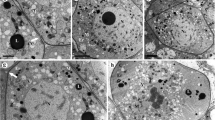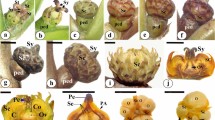Abstract
Staminate flowers of giant ragweed,Ambrosia trifida L. (Asteraceae, tribeHeliantheae, subtribeAmbrosiinae) were processed into resin and sectioned 1–2 µm thick. The invasive (amoeboid) anther tapetum remains parietal until microspores are released from tetrads, then it swells and invades the locule, merging gradually into a single protoplast that flows among the microspores. After the tapetal membrane ruptures at late microspore stage, tapetal debris fills the locule, then disappears as pollen matures. Pollen becomes tricelled before anthesis. The two sperm cell nuclei are slender and wormlike. The present report supports the two generalizations that invasive tapetum and tricelled pollen are attributes of theAsteraceae.
Similar content being viewed by others
References
Albertini, L., Souvré, A., Audran, J. C., 1987: Le tapis de l'anthère et ses relations avec les microsporocytes et les grains de pollen. — Rev. Cytol. Biol. Veget. Bot.10: 211–242.
Bhandari, N. N., 1984: The microsporangium. — InJohri, B. M., (Ed.): Embryology of angiosperms. — Berlin, Heidelberg, New York, Tokyo: Springer.
Brewbaker, J. L., 1967: The distribution and phylogenetic significance of binucleate and trinucleate pollen grains in the angiosperms. — Amer. J. Bot.54: 1069–1083.
Davis, G. L., 1966: Systematic embryology of the angiosperms. — New York: Wiley.
Heslop-Harrison, J., 1969: An acetolysis-resistant membrane investing tapetum and sporogenous tissue in the anthers of certainCompositae. — Canad. J. Bot.47: 541–542.
Horner, H. T., Jr., 1977: A comparative light- and electron microscopic study of microsporogenesis in male-fertile and cytoplasmic male-sterile sunflower (Helianthus annuus). — Amer. J. Bot.64: 745–759.
—,Pearson, C. B., 1978: Pollen wall and aperture development inHelianthus annuus (Compositae: Heliantheae). — Amer. J. Bot.65: 293–309.
Maheshwari Devi, H., 1963: Embryological studies in theCompositae. 4.Heliantheae. — Proc. Indian Acad. Sci., Sect. B,58: 274–290.
Pacini, E., Franchi, G. G., Hesse, M., 1985: The tapetum: its form, function, and possible phylogeny inEmbryophyta. — Pl. Syst. Evol.149: 155–185.
Pullaiah, T., 1984: Embryology ofCompositae. — New Delhi: Today and Tomorrow's Printers & Publishers.
Robinson, H., 1981: A revision of the tribal and subtribal limits of theHeliantheae (Asteraceae). — Smithsonian Contrib. Bot.51: 1–102.
Sporne, K. R., 1973: A note on the evolutionary status of tapetal types in dicotyledons. — New Phytol.72: 1173–1174.
Stuessy, T. F., 1977:Heliantheae—systematic review. — InHeywood, V. H., Harborne, J. B., Turner, B. L. (Eds.): The biology and chemistry of theCompositae. — London: Academic Press.
Sun, M., Ganders, F. R., 1987: Microsporogenesis in male-sterile and hermaphroditic plants of nine gynodioecious taxa of HawaiianBidens (Asteraceae). — Amer. J. Bot.74: 209–217.
Villari, R., 1987a: Embryology ofHelichrysum rupestre (Rafin.) DC. var.messerii Pignatti (Inuleae, Asteraceae). — G. Bot. Ital.121: 27–40.
—, 1987b: Embryological observations onHelichrysum rupestre (Rafin.) DC. var.errerae (Tineo)Pignatti. — G. Bot. Ital.121: 133–138.
Weberling, F., Hildenbrand, M., 1982: Zur Tapetumentwicklung beiTriosetum L.,Leycesteria Wall. undKolkwitzia Graebn. (Caprifoliaceae). — Beitr. Biol. Pflanzen57: 481–486.
—, —, 1986: Weitere Untersuchungen zur Tapetumentwicklung derCaprifoliaceae. — Beitr. Biol. Pflanzen61: 3–20.
Author information
Authors and Affiliations
Rights and permissions
About this article
Cite this article
Lersten, N.R., Curtis, J.D. Invasive tapetum and tricelled pollen inAmbrosia trifida (Asteraceae, tribeHeliantheae). Pl Syst Evol 169, 237–243 (1990). https://doi.org/10.1007/BF00937677
Received:
Issue Date:
DOI: https://doi.org/10.1007/BF00937677




